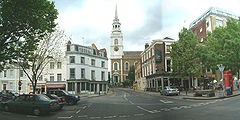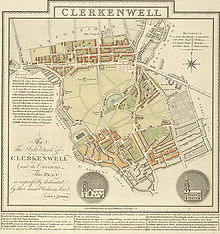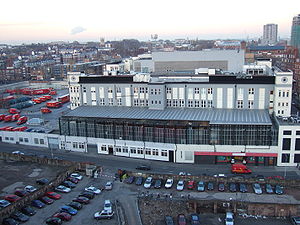- Clerkenwell
-
Coordinates: 51°31′34″N 0°06′13″W / 51.52604°N 0.103475°W
Clerkenwell 
Clerkenwell Green and St James's Church
 Clerkenwell shown within Greater London
Clerkenwell shown within Greater LondonOS grid reference TQ315825 London borough Islington Ceremonial county Greater London Region London Country England Sovereign state United Kingdom Post town LONDON Postcode district EC1 Dialling code 020 Police Metropolitan Fire London Ambulance London EU Parliament London UK Parliament Islington South and Finsbury London Assembly North East List of places: UK • England • London Clerkenwell (
 /ˈklɑrkənwɛl/) is an area of central London in the London Borough of Islington. From 1900 to 1965 it was part of the Metropolitan Borough of Finsbury. The well after which it was named was rediscovered in 1924. The watchmaking and watch repairing trades were once of great importance.[1] Clerkenwell was once known as London's "Little Italy" because of the large number of Italians living in the area from the 1850s until the 1960s.
/ˈklɑrkənwɛl/) is an area of central London in the London Borough of Islington. From 1900 to 1965 it was part of the Metropolitan Borough of Finsbury. The well after which it was named was rediscovered in 1924. The watchmaking and watch repairing trades were once of great importance.[1] Clerkenwell was once known as London's "Little Italy" because of the large number of Italians living in the area from the 1850s until the 1960s.Contents
History
Clerks' Well
Clerkenwell took its name from the Clerks' Well in Farringdon Lane (clerken was the Middle English genitive plural of clerk, a variant of clerc, meaning literate person or clergyman). In the Middle Ages, the London Parish clerks performed annual mystery plays there, based on biblical themes. Part of the well remains visible, incorporated into a 1980s building called Well Court. It is visible through a window of that building on Farringdon Lane. Access to the well is managed by Islington Local History Centre and visits can be arranged by appointment.
Monastic traditions
The Monastic Order of the Knights Hospitallers of St John of Jerusalem had its English headquarters at the Priory of Clerkenwell. (The Blessed Gerard founded the Order to provide medical assistance during the crusades.) St John's Gate (built by Sir Thomas Docwra in 1504) survives in the rebuilt form of the Priory Gate. Its gateway, erected in 1504 and remaining in St John's Square, served various purposes after the Dissolution of the Monasteries. For example, it was the birthplace of the Gentleman's Magazine in 1731, and the scene of Dr Johnson's work in connection with that journal.
In modern times the gatehouse again became associated with the Order and was in the early 20th century the headquarters of the St John Ambulance Association. An Early English crypt remains beneath the chapel of the Order, which was otherwise mostly rebuilt in the 1950s after wartime bombing. The notorious deception of the "Cock Lane Ghost", in which Johnson took great interest, was perpetrated nearby.
Adjoining the priory was St Mary's nunnery of the Benedictine order, now entirely disappeared, and St James's Church, rebuilt in 1792 on the site of the original church which was partly of Norman provenance. The Charterhouse, near the boundary with the City of London, was originally a Carthusian monastery. Following the Dissolution of the Monasteries the Charterhouse became a private mansion and one owner, Thomas Sutton, subsequently left it with an endowment as a school and almshouse. The latter still remains but the school relocated to Surrey and its part of the site is today the medical school for Barts Hospital.
Fashionable residential area
In the 17th century South Clerkenwell became a fashionable place of residence. Oliver Cromwell owned a house on Clerkenwell Close, just off the Green. Several aristocrats had houses there, most notably the Duke of Northumberland,[citation needed] as did people such as Erasmus Smith.[2] Before Clerkenwell became a built-up area, it had a reputation as a resort a short walk out of the city, where Londoners could disport themselves at its spas, of which there were several, based on natural chalybeate springs, tea gardens and theatres. The present day Sadler's Wells has survived as heir to this tradition, after being rebuilt many times and many changes of use including pleasure gardens, theatre, aquatic display venue, circus, music hall. Today it is a leading theatre and modern dance venue.
Clerkenwell was also the location of three prisons: the Clerkenwell Bridewell, Coldbath Fields Prison (later Clerkenwell Gaol) and the New Prison, later the House of Detention, notorious as the scene of an attempted prison break in 1867 by Fenian rebels who sought to blow up part of the building.
Industrial Revolution
The Industrial Revolution changed the area greatly. It became a centre for breweries, distilleries and the printing industry. It gained an especial reputation for the making of clocks and watches, which activity once employed many people from around the area. Flourishing craft workshops still carry on some of the traditional trades, such as jewellery-making. Clerkenwell is home to Witherby's, Europe's oldest printing company. The company, which was established in 1740 and whose shareholding is mainly family-held, produces a wide variety of commercial work such as magazines, leaflets, report and accounts, brochures and information packs at its on-site print facility.
Clerkenwell Green
Clerkenwell Green lies at the centre of the old village, by the church, and has a mixture of housing, offices and pubs, dominated by the imposing former Middlesex Sessions House. It was built in 1782, extended during the Victorian era, and by the early 21st century used as a Masonic hall. The name is something of a historical relic—Clerkenwell Green has had no grass for over 300 years. However, in conveying some impression of its history, it gives the appearance of one of the better-preserved village centres in what is now central London. In Charles Dickens's Oliver Twist, Clerkenwell Green is where Fagin and the Artful Dodger induct Oliver into pickpocketing amongst shoppers in the busy market once held there. Indeed, Dickens knew the area well and was a customer of the Finsbury Savings Bank on Sekforde Street, a street linking Clerkenwell Green to St John Street.
Radicalism
Clerkenwell Green has historically been associated with radicalism, from the Lollards in the 16th century, the Chartists in the 19th century and communists in the early 20th century.[3] In 1902, Vladimir Lenin moved the publication of the Iskra (Spark) to the British Social Democratic Federation at 37a Clerkenwell Green, and issues 22 to 38 were indeed edited there. At that time Vladimir Lenin resided on Percy Circus, less than half a mile north of Clerkenwell Green. In 1903 the newspaper was moved to Geneva. It is said that Lenin and a young Joseph Stalin met in the Crown and Anchor pub (now known as The Crown Tavern) on the Green when the latter was visiting London in 1903. In the 1920s and 1930s, 37a Clerkenwell Green was a venue for Communist Party meetings, and the Marx Memorial Library was founded on the same site in 1933. Clerkenwell's tradition of left-leaning publication continued until late 2008 with The Guardian and The Observer having their headquarters on Farringdon Road, a short walk from the Green. Their new offices are a short distance away in King's Cross. In 2011 an anti-cuts protest march departed from Clerkenwell and ended with a rally at Trafalgar Square demanding trade union rights, human rights and international solidarity.[4]
Local government
Clerkenwell St James was an ancient parish in the Finsbury division of the Ossulstone hundred of Middlesex.[5] The parish vestry became a nominating authority to the Metropolitan Board of Works in 1855. The area of the metropolitan board became the County of London in 1889. A reform of local government in 1900 abolished the Clerkenwell vestry and the parish became part of the Metropolitan Borough of Finsbury. Alexandra Park, an exclave of the parish, was transferred to Hornsey, Middlesex at the same time.[5] Clerkenwell Town Hall, which had been built on Rosebery Avenue in 1895, became Finsbury Town Hall. Finsbury became part of the London Borough of Islington in 1965 and the old town hall lay empty and deteriorating for many years. It has since been sold to the Urdang Dance Academy.
Post-war de-industrialisation and revival
After the Second World War Clerkenwell suffered from industrial decline and many of the premises occupied by the engineering, printing publishing and meat and food trades (the last mostly around Smithfield) fell empty. Several acclaimed council housing estates were commissioned by Finsbury Borough Council. Modernist architect and Russian émigré Berthold Lubetkin's listed Spa Green Estate, constructed 1943–1950, has recently been restored. The Finsbury Estate, constructed in 1968 to the designs of Joseph Emberton includes flats, since altered and re-clad.
A general revival and gentrification process began in the 1980s, and the area is now known for loft-living in some of the former industrial buildings. It also has young professionals, nightclubs and restaurants and is home many professional offices as an overspill for the nearby City of London and West End. Amongst other sectors, there is a notable concentration of design professions around Clerkenwell, and supporting industries such as high-end designer furniture showrooms. It is claimed that the area has the highest concentration of architects and building professionals in the world. Many of London's leading architectural practices have offices in the area.
On 4 November 2010 Prime Minister David Cameron revealed in a speech given in East London that Clerkenwell would form part of a new East London Tech City hub.[6]
Entertainment
Theatre
In April 2011, the former Middlesex Prison on Sans Walk (known as the House of Detention Clerkenwell) became the setting for a production of Shakespeare's Macbeth. Presented by Belt Up Theatre, a company heralded as "The bright young things changing the future of British theatre" by The Observer.[7]
Public houses
Pubs that serve the Smithfield market meat workers are allowed to open at 5.30 am. These are Nicholson's Brewery's former gin palace The Fox & Anchor, The Hope, and The Cock Tavern (which is situated under the market itself).
London's first gastropub, The Eagle, opened in Clerkenwell in 1991. The Eagle has been joined by, among others, The Peasant, The Coach and Horses, and The Gunmakers and The Green, which as part of a nationwide evolution of the traditional public house have since converted to gastropubs.
It is said that Vladimir Lenin and a young Joseph Stalin met in the Crown and Anchor pub (now known as The Crown Tavern) on Clerkenwell Green when the latter was visiting London in 1903.[8]
The Betsey Trotwood (named after Betsey Trotwood in David Copperfield by Charles Dickens) adopted the name in 1983, having previously been The Butcher's Arms.[9]
Restaurants
Clerkenwell is home to some of the best restaurants in London,[10] including St John, a traditional English restaurant. The Spanish/Moroccan restaurant Moro, Bistrot Loubet, the Michelin starred Club Gascon, Café du Marché" and others contribute to the area's gastronomic reputation.
Bars
Clerkenwell is the home of several bars including Smith's of Smithfield and The Slaughtered Lamb. The evening economy is centred on the north side of Smithfield Market (the trading hours are from 4:00 am to 12:00 noon every weekday), with bar customers gathering amidst trucks of carcasses at the all-night meat market, except on Saturdays and Sundays when it is closed.
Notable people
- John Bell, Anglican bishop
- Thomas Birch
- Thomas Britton
- James Duff Brown, librarian
- Robert Burnside
- Phil Cameron
- William Cavendish, 1st Duke of Newcastle
- Earl of Clanricarde
- Tim Crane
- Oliver Cromwell, soldier and statesman
- Daniel Defoe, journalist and writer
- Charles Dickens, novelist
- Zaha Hadid
- John Holwell
- Anthony Horowitz, novelist and screenwriter
- Vladimir Lenin, a visitor
- Charles Sabini, criminal, leader of the Sabini gang
- David Thewlis
- Louis Wain, painter
- John Weever
- John Wilkes
Nearby areas
- St Pancras to the west
- Bloomsbury to the west
- Hatton Garden to the west
- Holborn to the southwest
- Smithfield to the south
- Barbican Estate and Barbican Arts Centre to the southeast
- Golden Lane Estate to the east
- St Luke's to the east
- Finsbury Estate to the north
- Islington to the north
- King's Cross to the northwest
Nearest railway and London Underground stations
Farringdon station, which provides both mainline rail and tube services, is the only station in Clerkenwell itself. However Angel, King's Cross St Pancras, Chancery Lane and Barbican stations all lie near the fringes of Clerkenwell.
References
- ^ Moore, W. G. (1971) The Penguin Encyclopedia of Places. Harmondsworth: Penguin Books; p. 178
- ^ "Smith, Erasmus", on the website of the Oxford Dictionary of National Biography (Subscription or UK public library membership required), http://dx.doi.org/10.1093/ref:odnb/25796
- ^ Andrew Rothstein, A House on Clerkenwell Green, London: Lawrence & Wishart, 1966. A history of 37a Clerkenwell Green and activism in the area.
- ^ "May Day: Thousands participate in rally". BBC News. 1 May 2011. http://www.bbc.co.uk/news/uk-england-13254761.
- ^ a b Vision of Britain - Clerknwell parish (historic map). Retrieved on 2009-11-05.
- ^ "East End tech city speech". Number 10. http://www.number10.gov.uk/news/speeches-and-transcripts/2010/11/east-end-tech-city-speech-56602. Retrieved 4 November 2010.
- ^ Carter, Imogen; Lamont, Tom; Kappala-Ramsamy, Gemma (13 February 2011). "Meet the bright new things of British theatre". The Guardian (London). http://www.guardian.co.uk/stage/2011/feb/13/new-british-theatre-companies.
- ^ "Lenin and Stalin meeting", The Shady Old Lady, http://www.shadyoldlady.com/location.php?loc=2007, retrieved 16 June 2011
- ^ Website of The Betsey Trotwood
- ^ New York Times article on Clerkenwell's history and restaurant scene
External links
London/Holborn-Clerkenwell travel guide from Wikitravel
- Map of Clerkenwell, showing location of the Clerks' Well
- Description and history of Clerkenwell from an 1868 Gazetteer
- Islington Museum and Local History Centre
- Information about Lenin's stay in Clerkenwell
- Craft Central
- St James Church Clerkenwell
- St Mark's Church, Myddelton Square, Clerkenwell
- GraceLife London at Woodbridge Chapel, for many years known as Clerkenwell Medical Mission
List of places in London Major districts Abbey Wood · Acton · Barking · Barnes · Barnet · Barnsbury · Battersea · Beckenham · Bermondsey · Bethnal Green · Bexleyheath · Bloomsbury · Bow · Brentford · Brixton · Brockley · Bromley · Camberwell · Camden Town · Canonbury · Carshalton · Catford · Charlton · Chelsea · Chessington · Chingford · Chislehurst · Chiswick · City · Clapham · Clerkenwell · Cricklewood · Coulsdon · Croydon · Dagenham · Deptford · Ealing · East Ham · Edmonton · Eltham · Enfield Town · Erith · Feltham · Finchley · Forest Hill · Forest Gate · Fulham · Greenwich · Hackney · Hammersmith · Hampstead · Harrow · Hendon · Highams Park · Highbury · Highgate · Hillingdon · Holborn · Hook · Holloway · Hornchurch · Hounslow · Ilford · Isle of Dogs · Isleworth · Islington · Kensington · Kentish Town · Kensal Green · Kilburn · Kingston upon Thames · Lambeth · Lewisham · Leyton · Marylebone · Mayfair · Mitcham · Morden · Muswell Hill · New Cross · New Malden · Orpington · Paddington · Peckham · Penge · Pinner · Poplar · Purley · Putney · Richmond · Romford · Ruislip · Shepherd's Bush · Shoreditch · Sidcup · Soho · Southall · Southgate · South Norwood · Southwark · Stepney · Stoke Newington · Stratford · Streatham · Surbiton · Sutton · Sydenham · Teddington · Thamesmead · Tolworth · Tooting · Tottenham · Twickenham · Upminster · Upper Clapton · Uxbridge · Walthamstow · Wandsworth · Wanstead · Wapping · Wealdstone · Welling · Wembley · West Ham · Westminster · West Norwood · Whitechapel · Willesden · Wimbledon · Wood Green · Woodford · Woolwich
Barking and Dagenham · Barnet · Bexley · Brent · Bromley · Camden · Croydon · Ealing · Enfield · Greenwich · Hackney · Hammersmith and Fulham · Haringey · Harrow · Havering · Hillingdon · Hounslow · Islington · Kensington and Chelsea · Kingston · Lambeth · Lewisham · Merton · Newham · Redbridge · Richmond · Southwark · Sutton · Tower Hamlets · Waltham Forest · Wandsworth · Westminster
Metropolitan Board of Works Districts Fulham · Greenwich · Hackney · Holborn · Lee/Plumstead · Lewisham · Limehouse · Poplar · St Giles · St Olave · St Saviour's · Strand · Wandsworth · Westminster · Whitechapel
Headquarters at Spring GardensIncorporated vestries Battersea · Bermondsey · Bethnal Green · Camberwell · Chelsea · Clerkenwell · Fulham · Hackney · Hammersmith · Hampstead · Islington · Kensington · Lambeth · Mile End Old Town · Newington · Paddington · Plumstead · Rotherhithe · St George Hanover Square · St George in the East · St Luke Middlesex · St Martin in the Fields · St Marylebone · St Pancras · Stoke Newington · Shoreditch · Southwark St George the Martyr · Westminster St Margaret and St John · Westminster St James · WoolwichUndertakings Major works Legislation Royal Commission on the City of London · Metropolis Management Act 1855 · Metropolis Toll Bridges Act 1877 · Metropolitan Board of Works (Money) Act 1885 · Metropolis Management Amendment Act 1885 · Local Government Act 1888 · London Government Act 1899People University of the Arts London Colleges and
subdivisions
University CampusCamberwell · Charing Cross Road · Clerkenwell · Elephant and Castle · Hackney · High Holborn · Holborn · Merton Park · Millbank · Oxford Street · WimbledonPeopleAcademics · Alumni · Chairman: Sir John Tusa · Rector: Nigel CarringtonOtherAffiliates London Centre for Arts and Cultural Exchange · Universities UK
Categories:- Parishes governed by vestries (Metropolis)
- Districts of Islington
- Districts of London
Wikimedia Foundation. 2010.




